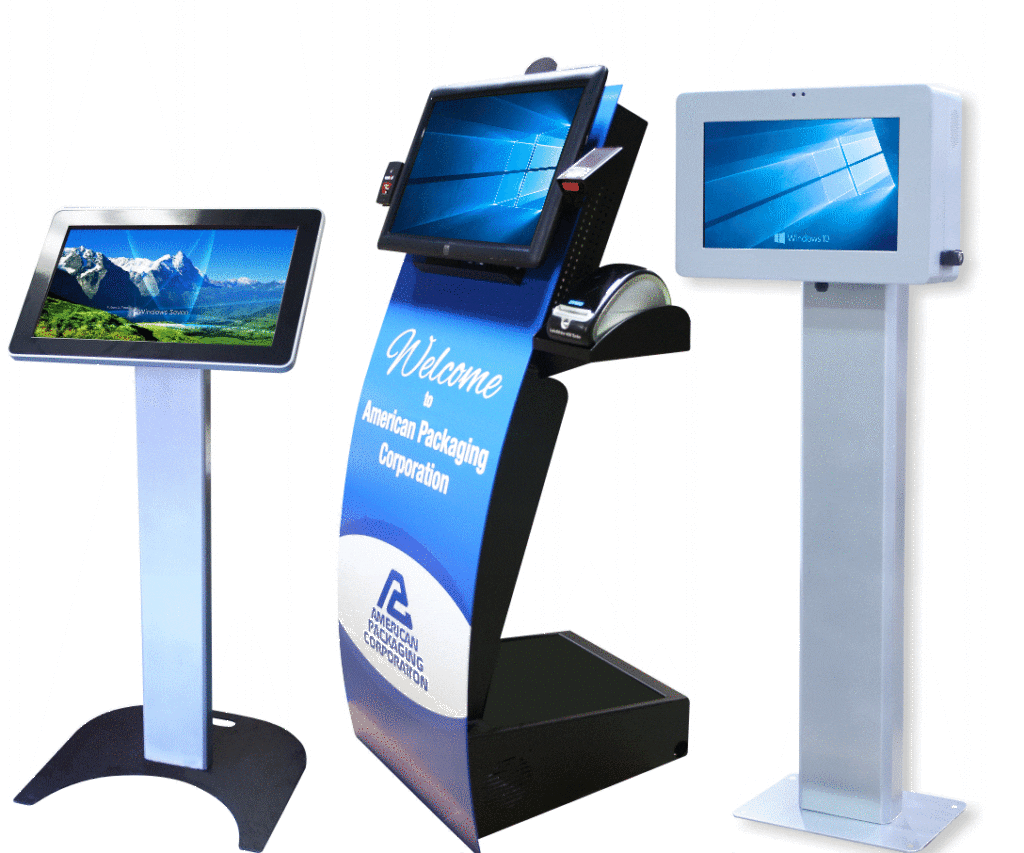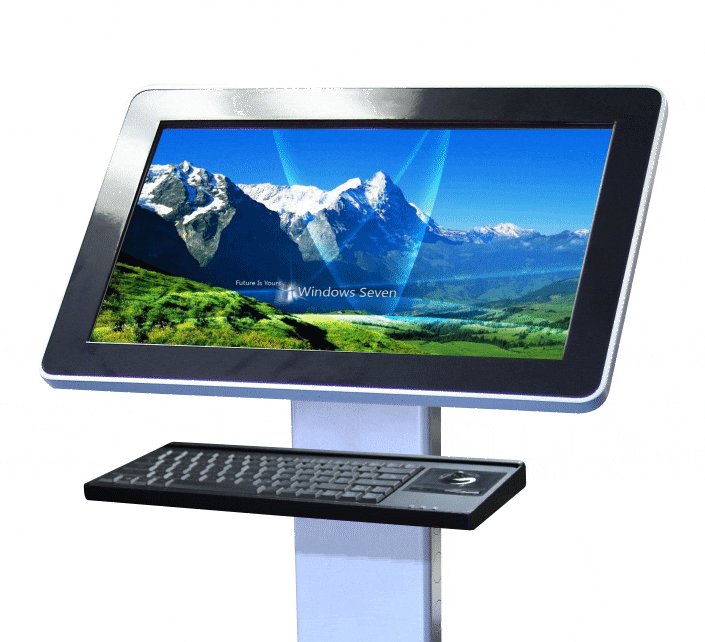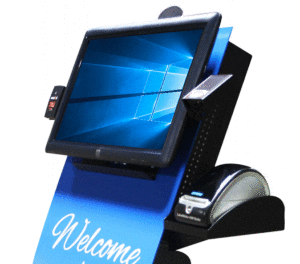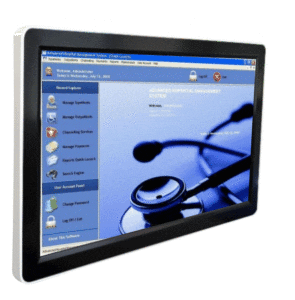How Much Do Interactive Kiosks Cost in 2024?
Cost and Configuration Buyer’s Guide

In 2024 interactive Kiosks cost between $1,200 to $10,500 depending on display size, interface, and items such as ticketing, POS, or retail marketing. Other factors may include internet access, using digital photos, trade shows, or human resources.
Creating a buyer’s guide for interactive kiosks involves considering several factors, such as the types of kiosks available, their costs, and the features each type offers. Here’s a comprehensive guide to help you understand the landscape:
1. Types of Interactive Kiosks
a. Information Kiosks
- Description: Used for providing information, such as in malls, tourist spots, and public areas.
- Features: Touchscreens, multimedia content, internet connectivity.
- Typical Locations: Shopping centers, museums, transportation hubs.
b. Self-Service Kiosks
- Description: Enable users to perform tasks like ticketing, check-in, or food ordering.
- Features: Payment processing capabilities, printers, scanners.
- Typical Locations: Airports, fast-food restaurants, cinemas.
c. Wayfinding Kiosks
- Description: Help users navigate large complexes or areas.
- Features: Interactive maps, search functionality, multilingual support.
- Typical Locations: Hospitals, universities, large corporate campuses.
d. Digital Signage Kiosks
- Description: Display advertisements, announcements, or public information.
- Features: High-resolution displays, often with touch interaction.
- Typical Locations: Retail stores, public squares, event venues.
e. Retail Kiosks
- Description: Focus on retail transactions, like product ordering or bill payment.
- Features: Barcode scanners, card readers, receipt printers.
- Typical Locations: Shopping malls, convenience stores, utility service centers.
2. Cost Factors
a. Hardware
- Range: $1,000 to $10,000+
- Factors: Screen size, build quality, specialized components like printers or scanners.
b. Software
- Range: $500 to $5,000 (one-time or annual licensing)
- Factors: Customization level, software complexity, ongoing support or updates.
c. Maintenance
- Range: Varies widely
- Factors: Warranty, frequency of maintenance, on-site or remote support.
d. Connectivity
- Range: Monthly fees
- Factors: Internet connection type, data usage plans.
3. Considerations When Buying
a. Purpose and Location
- Match the kiosk type to its intended use and location.
- Consider environmental factors like weather for outdoor kiosks.
b. User Interface and Accessibility
- Ensure easy navigation and ADA compliance for accessibility.
- Consider multilingual support for diverse user groups.
c. Security and Privacy
- Secure payment processing for transactional kiosks.
- Data protection measures for user information.
d. Customization and Scalability
- Ability to customize software and hardware as per specific needs.
- Scalability for future expansion or technology upgrades.
e. Vendor Support and Warranty
- Check for vendor’s support services and warranty terms.
- Consider long-term reliability and vendor reputation.
4. Additional Points to Consider
Investing in an interactive kiosk requires careful consideration of its type, cost, and the specific needs it will fulfill. Balancing upfront costs with long-term benefits and support is key to making a worthwhile investment. Always research vendors thoroughly and consider future scalability when choosing a kiosk solution.
COMPARE KIOSK QUOTESWhere to Buy Kiosks
When looking to purchase interactive kiosks, you have several options ranging from specialized manufacturers to online retailers. Here’s a guide on where to buy and what to consider:
1. Specialized Kiosk Manufacturers
- Description: Companies that focus exclusively on producing interactive kiosks.
- Advantages: Customization options, expert advice, dedicated support.
- Considerations: May require a larger budget, longer lead times for customized orders.
- Examples: Kiosk Information Systems, Olea Kiosks, ZIVELO.
2. Commercial Technology Suppliers
- Description: Suppliers that offer a wide range of commercial technology solutions, including kiosks.
- Advantages: Broader range of products, potentially more competitive pricing.
- Considerations: May have less specialization in kiosks.
- Examples: CDW, Insight, B&H Photo Video.
3. Online Marketplaces
- Description: Platforms like Amazon, Alibaba, or eBay.
- Advantages: Convenience, variety, potential for lower prices.
- Considerations: Varying quality, limited customization, less customer support.
- Tips: Look for vendors with high ratings and good reviews.
4. Direct Purchase from Software Providers
- Description: Some kiosk software providers also offer hardware solutions.
- Advantages: Integrated software and hardware solutions.
- Considerations: Options may be limited to what works best with their software.
5. Local Electronics Stores
- Description: Some local stores might offer basic kiosk models or can order them.
- Advantages: Physical inspection, local support.
- Considerations: Limited selection, potentially higher prices.
6. Trade Shows and Expos
- Description: Industry events where manufacturers showcase their latest products.
- Advantages: Opportunity to see a wide range of products and innovations, network with suppliers.
- Considerations: Occur at specific times and locations, may require travel.
Key Considerations When Buying
- Research: Read reviews, case studies, and ask for references.
- Budget: Factor in the total cost of ownership, including maintenance and software.
- Customization: Ensure the kiosk can be tailored to your specific needs.
- Warranty and Support: Check for warranty terms and ongoing support options.
- Software Compatibility: Ensure the hardware is compatible with your intended software solution.
Final Tips
- Request Demos: If possible, request a demo unit or visit a showroom.
- Compare Quotes: Get quotes from multiple suppliers to compare prices and offerings.
- Check Lead Times: Especially for customized orders, check the expected delivery time.
- Plan for Future Needs: Consider scalability and future upgrades.
By exploring these options and considering your specific needs and budget, you can find the right source for your interactive kiosks. Remember, the cheapest option isn’t always the best in the long run, especially for a technology-driven product like an interactive kiosk.
COMPARE KIOSK QUOTESINDOOR/OUTDOOR KIOSKS
The greatest impact on kiosk cost is whether the kiosk is for indoor or outdoor use. Outdoor kiosks by definition cost considerably more than indoor kiosks because of the many upgrades and changes needed for a kiosk to operate in wide temperature ranges and weather.
Outdoor kiosks require water-sealed, outdoor powder-coated enclosures, internal heating and cooling systems, wide-temperature RAM and wide-temperature solid-state drives, high-brightness LCDs with cooling technology to allow exposure to sunlight and several other outdoor kiosk modifications.
Indoor 21.5” base pricing with no stand or peripherals ranges from $1,110 to $2,020 depending on CPU, RAM, and Video Card configuration.
Outdoor 21.5” base pricing with no stand or peripherals ranges from $2,803 to $3,702 depending on CPU, RAM, and Video Card configuration.
MOUNTING
The next fundamental question is how is the kiosk mounted? To a wall, or on a stand? Or maybe a countertop/desktop? A wall-mount is lower cost and works great if you happen to have a wall in the right place, while a stand can be deployed anywhere but is more costly and does require some available floor space.
There are also different types of kiosk stands. There are lower-cost alternatives that are small and typically do not securely enclose any peripherals, and higher-end kiosk enclosures that have internal locking compartments for peripherals and accessories. Kiosk stand choice can also affect custom decals or branding that may be wanted on the kiosk.
COMPARE KIOSK QUOTESPC
This cost can vary from a low-end J1900 CPU with 4GB RAM and onboard video to an i7 CPU with 32GB RAM and a 4GB video card.
The PC used in the kiosk is no different from a functional perspective than any desktop PC. Like a desktop PC, there are configuration choices including CPU, RAM, graphics, connectivity, and operating system that must be tailored to the software application that will be running on the kiosk.
Also, does the kiosk need to connect to the internet? How? WiFi, wired LAN, or 3G/4G cellular? All of these choices impact the price.
TOUCHSCREEN
The choices made can vary the cost from no touch or keyboard (display only), to both touchscreen and keyboard.
The choice to use a touchscreen, keyboard, or both should be based on the application software and how much data the user may be expected to input. A touchscreen works best on a larger screen size when the user is presented with clear touch choices on the kiosk screen, with little or no keyboard input required. If some keyboard input is required, a virtual keyboard can be used for that.
If the user is required to input a lot of data, a keyboard with a pointing device like a trackball may be mounted on the front of the kiosk.
 PERIPHERALS:
PERIPHERALS:
Kiosk peripheral choices can range from none to many including kiosk printers, credit card readers, barcode scanners, keyboards, RFID readers, cameras, and more.
The peripheral choice is tied to the application. For example, a payment kiosk may require a credit card reader, a bill acceptor, or a chip reader while an internet access kiosk or information kiosk usually has no peripheral requirements.
How Much Do These Kiosks Cost?
Now it’s time to talk about money. How much does a touch screen kiosk cost exactly? The answer varies.
Here are some baseline prices you can expect as you shop for your kiosk:
- $1,126 for base indoor kiosk
- $770 for bill validator
- $71 for the card reader
- $40 for kiosk software
- $990 for the enclosure
- $184 for keyboard
- $188 for upgraded CPU
- $790 for internal thermal kiosk printer
- $420 for a 15-inch LCD touchscreen
- $459 for a 17-inch LCD touchscreen
There are extra prices associated with getting your touchscreen kiosk up and running. These are as follows:
- $320 for initial project management
- $1,050 for installation
- $3,609 for 36 months of software support
- $1,850 for 36 months of management software
That puts your total at $11,600+ per kiosk. Some of those prices, such as the continued software support and management software, are recurring. You’ll have to pay for those every three years.
What are the benefits and applications of touchscreen kiosks?
Touch screen interactive kiosks, also known as self-serve kiosks, place 24/7 access to products and services in any location for the benefit and convenience of users and customers. Kiosks are a force multiplier and allow owners to broaden and enhance their reach to their customers. Below are just a few examples of indoor and outdoor kiosk applications:
INFORMATION KIOSKS and INTERNET ACCESS KIOSKS
Information and internet access kiosks are a broad application area. These kiosk applications usually allow users to browse and interact with information on websites in a controlled way that would give the kiosk user the ability to visit certain selected pages. This is done by using a product referred to as “browser lock-down” software, which is available from several providers.
Some common information kiosk applications include:
Wayfinding Kiosk: This provides a map and directory to the user for use in parks and recreation areas, events, building lobbies, cemeteries, etc. These touch kiosks usually do not require any additional kiosk peripherals.
Product Lookup Kiosk and Price Check Kiosks: Provides online access to product information and/or pricing. These kiosks may include a barcode scanner for easier product and price lookup.
Trade Show kiosk: Touch kiosks are perfect to take to trade shows because they can present booth visitors with a huge amount of product information along with marketing material, photos, videos, etc. And the kiosks can capture visitor information for follow-up using a barcode scanner or magnetic card reader. These kiosks usually include a barcode scanner and/or magnetic card reader to capture visitor information for lead follow-up.
Museum Kiosk: Museums love interactive kiosks. What better way to enhance and deepen a museum exhibit than with a large-screen, interactive touch kiosk that can display a wealth of information to the visitor? From hi-resolution photos to HD videos, these kiosks can be any size but usually tend to be larger, 32” and up, to present the user with greater impact.
TASK SPECIFIC and SELF-SERVE KIOSKS
Touch kiosks can perform a wide range of tasks for users including registering users for events, self-check-in, accepting payments and donations, point of care, access control, and more.
Some common task-specific and self-serve kiosk applications include:
 Check-in Kiosks
Check-in Kiosks
Hotel check-in, flight check-in, community event check-in, healthcare check-in, and child-check-in are among dozens of kiosk check-in applications in common use. These kiosks typically have peripherals like a label printer, barcode scanner, and card reader for check-in verification and validation, but could also just be a touch screen with no additional peripherals.
Visitor Kiosks
Many companies require visitors to log in when they arrive, confirm their appointments, and to wear visitor badges while in the building. A kiosk can perform all of these tasks for the user including taking a picture of the user and even creating the visitor badge. A webcam, barcode scanner, card reader, and specialized printer can all be used by the kiosk for this application.
Access Control Kiosks
Access control and security kiosks are used to verify a user’s identity, and then allow access to a building, room, or another secure area. Gate control kiosks are outdoor kiosks that control gate access. These kiosks may have peripherals that include biometric scanning, such as fingerprint or palm, barcode, and magnetic card readers, and cameras.
Payment Kiosks
Accepting payments is a natural self-service application for kiosks. If a website can accept a payment, so can a remote kiosk. Usually, a credit card reader is used for most applications, but a bill acceptor can also be used, and even more exotic peripherals such as check readers and bill recyclers can also be used in the high-end machines. Bill payment kiosks with these kinds of peripherals need to have specific software developed exclusively for their use.
 Donation Kiosk
Donation Kiosk
Donation kiosks are another form of payment kiosk. Typically a donation kiosk is simpler, and most commonly may only use a card reader to accept the donation.
Point of Care Kiosks
Used in hospitals and assisted living facilities and retirement homes, point of care kiosks, or POC, are typically mounted on walls in hallways to document patient ADLs (Activities of Daily Living) and pertinent care for Medicare billing and to retain accreditation and rating.
COMPARE KIOSK QUOTES










